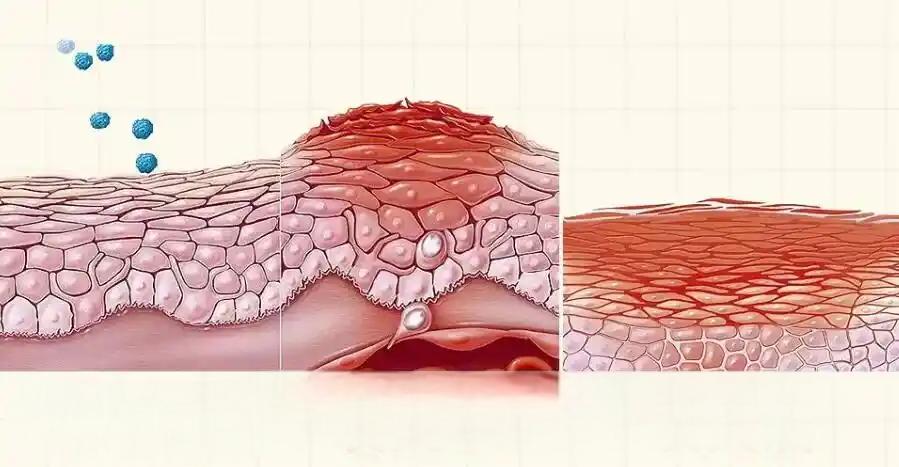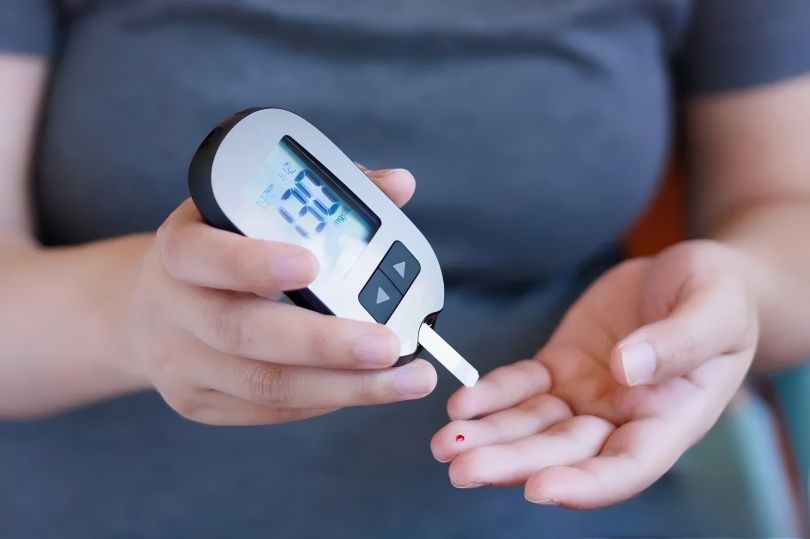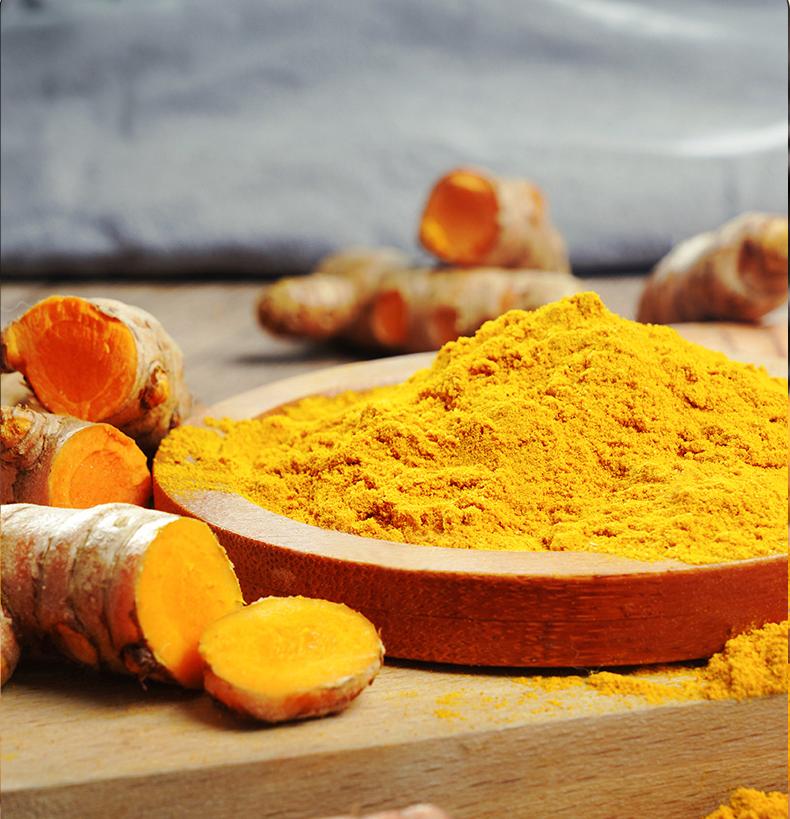Study on Powdered Turmeric for Inflammation
Turmeric is mainly cultivated in tropical and subtropical regions and produced primarily in India. It has traditionally been used to flavor food, dye fabrics, and treat various human diseases [1]. Curcumin is extracted from turmeric by various methods (e.g., Soxhlet, ultrasound, microwave, and supercritical carbon dioxide) in solvent extraction (ethanol preferred) followed by purification by column chromatography [2].
This extract, in addition to other macro- and micronutrients, contains 77% curcuminoids, 17% demethoxycurcumin and 3% bisdemethoxycurcumin, collectively named curcumin (Cur cumin), which gives the yellow turmeric its different shades of yellow [3]. Curcumin is a lipophilic polyphenol, soluble in water, and stable at acidic pH [4]. Doses of up to 8 g/d have been reported in human studies with no evidence of resistance [5]. Since the identification of curcumin as the major constituent of turmeric, a wide range of pharmacological activities including antioxidant, anti-inflammatory, anti-tumor and anti-diabetic activities have been reported for curcumin, which has a number of molecular targets and therefore a complex mechanism of action.
1 Pharmacological effects of curcumin
1.1 Antioxidant effects
Curcumin is considered an antioxidant due to the presence of a β-diketone group in its structure [6]. Joe and Lokesh determined in 1994 that the most important mechanism by which curcumin exerts most of its activity is the inhibition of superoxide radicals, hydrogen peroxide and nitric oxide [7]. Other researchers have suggested that curcumin activates antioxidant enzymes such as glutathione-S-transferase (GST), quinine reductase and haem oxygenase-1 [8].
Curcumin therefore has a protective effect against reactive oxygen species (ROS). In an in vitro model of ischemia-reperfusion using rat cortical neurons, curcumin was found to protect neurons from death caused by oxygen and glucose deprivation.
The authors of this study suggest that curcumin activates the antioxidant protein thioredoxin in the Nrf2 pathway [9]. In a study on curcumin by Wang et al. [10], the authors further investigated the role of curcumin in regulating cellular redox homeostasis. The seahorse bioenergetics analyzer was used to study changes in oxygen consumption and aerobic glycolysis rates. The results showed that curcumin enhanced the cellular oxidative stress of cancer cells by disrupting mitochondrial homeostasis and inducing severe apoptosis. Moreover, curcumin significantly reduced mt DNA content and DNA polymerase γ (POLG), which helped to reduce mitochondrial oxygen consumption and aerobic glycolysis. We found that curcumin induced POLG depletion through ROS production, and that POLG knockout also reduced oxidative phosphorylation (OX PHOS) activity and cellular glycolysis rate, which was partially rescued by the ROS scavenger NAC.
1.2 Anti-inflammatory effect
Curcumin can reduce inflammation by interacting with many inflammatory processes, which plays an important role in the development of chronic diseases such as autoimmune, cardiovascular, endocrine, neurodegenerative and tumor diseases in the inflammatory cascade. Oxidative stress can lead to chronic inflammation, and ROS production regulates the expression of the nuclear factor κB (NF-κβ) and tumor necrosis factor α (TNF-α) pathways, which play an important role in the inflammatory response [12].
On the one hand, the downregulation of the gene products of matrix degradation (matrix metalloproteinases -1, -9 and -13), prostaglandin production (cyclooxygenase -2), apoptosis (Bax and activated caspase -3) and stimulation of cell survival (Bcl-2), are known as NF-κB regulation. Buhrmann C et al. [13] investigated the anti-inflammatory effect of curcumin using an in vitro model of human tendon cells and found that curcumin inhibits the IKK (inhibitor of NF-κB nuclear factor κ-light chain enhancer) kinase (IKK) and the phosphorylation of AKT induced by IL-1β and the association between the two signal molecules passes through, and this leads to the inhibition of the phosphorylation and degradation of the nuclear factor of the κ light polypeptide gene enhancer in B cells inhibitor, α-(I KBα), an endogenous inhibitor of NF-κB.
They therefore showed that curcumin can inhibit the translocation of NF-κB into the nucleus, thereby preventing the inflammatory response of the cell. Curcumin also prevents the down-regulation of Bcl-2 and Bcl-XL expression stimulated by IL-1β and the increase in Bax and caspase-3 expression. The reduction in Bcl-2/Bax and Bcl-XL/Bad ratio is associated with a loss of mitochondrial membrane potential. Fu et al. [14] further found that curcumin also inhibits the phosphorylation of p38 and C-Jun N-terminal kinase (JNK) and increases the pro-survival signals of ERK and AKT, thereby suppressing the expression of apoptosis.

On the other hand, curcumin can reduce TNFα production and the cell signaling mediated by TNFα in various types of cells. In vitro and in vivo studies have suggested that curcumin acts as an NF-κB inhibitor because it directly binds to TNF-α [15]. In this sense, curcumin regulates TNF-α expression by inhibiting p300/CREB-specific acetyltransferase, which leads to the inhibition of histone/non-histone protein acetylation and thus transcription [16]. Li et al. [17] also showed in in vivo and in vitro experiments that curcumin induces higher levels of anti-inflammatory cytokines and reduces the production of pro-inflammatory cytokines, and can inhibit Ti particle-induced inflammation by regulating macrophage polarization. In addition, curcumin can also act as a free radical scavenger [18]. These data provide preliminary evidence that curcumin has good antioxidant stress and anti-inflammatory effects in experimental animals and humans.
1.3 Anti-tumor effect
Several preclinical studies have shown that curcumin is relatively safe for normal cells, but can induce apoptosis in tumor cells through different pathways [19]. The anti-tumor effects of curcumin are thought to be achieved through many different signaling pathways, such as cell proliferation [20], apoptosis [21], autophagy [22], angiogenesis [23], immune regulation [24], infiltration [25], and metastasis [26].
Some research data suggest that curcumin can induce G2/M cell cycle arrest and apoptosis, and recent work has attempted to explain how this cell cycle arrest occurs. Wu et al. [27] treated the U251 GBM cell line with curcumin in 2012 and found a dose-dependent increase in DAPK1 mRNA by real-time RT-PCR, and confirmed a corresponding increase in protein expression by western blot analysis. In addition, they used siRNA (si-DAPK1-1 and si-DAPK1-2) to transfect and inhibit DAPK1, and found that curcumin had the ability to inhibit the phosphorylation of STAT3 and NF-κB. They also showed that they knocked down DAP K1 to inhibit curcumin-mediated caspase-3 activation, resulting in a decrease in apoptosis (33.0% apoptotic cells versus 58.3% in the control group). These findings suggest that DAPK1 plays an important role in curcumin-mediated cell death.
In recent studies, micro RNAs, small non-coding RNA molecules associated with cancer progression, have been shown to be regulated by curcumin. Curcumin-induced micro RNA dysregulation may activate or inactivate a set of signaling pathways, such as the Akt, Bcl-2, PTEN, p53, Notch and Erbb signaling pathways [28]. Lelli D et al. [29] also found that the potential anticancer activity of curcumin and its analogues is mediated through miRNA regulation, for example, miRNA-21, which affects cell cycle regulation and apoptosis by downregulating the PTEN and PDCD4 proteins.
1.4 Anti-diabetic effect
Recent studies have shown that curcumin can improve obesity-related insulin resistance. In their study, Rains et al. [30] observed that curcumin has immunomodulatory effects on obesity and insulin resistance, as it reduces the cytokines TNF-α, MCP-1, glucose and glycosylated haemoglobin in diabetic rats [31].
A study using C57BL/Ks-db/db diabetic mice [32] showed that curcumin reduced blood glucose and glycosylated hemoglobin levels and increased plasma insulin levels and hepatic glucokinase activity. In addition, curcumin reduced glucose-6-phosphatase and phosphoenolpyruvate carboxykinase activities, lowered blood glucose levels and improved glucose tolerance.
Genq S et al. [33] found that treatment of HepG2 cells with 100 nM BPA for 5 days induced a significant reduction in glucose consumption, impaired insulin signaling, elevated proinflammatory cytokines and oxidative stress, and activation of signaling pathways; inhibition of the JNK and p38 pathways, rather than the ERK and NF-κB pathways, improved glucose consumption and insulin signaling in BPA-treated HepG2 cells.
In addition, we found that curcumin effectively attenuated the spectrum of insulin resistance induced by BPA, and pretreatment with the JNK and p38 activator anisomycin significantly compensated for the effects caused by curcumin. Meanwhile, some researchers [34] found that in rats with induced diabetes, compared with untreated rats, those treated with zinc and curcumin had significantly increased catalase, significantly reduced glucose, lipid profile components and arylsulfatase activity. Therefore, zinc and curcumin are protective agents against metabolic defects in diabetes.

1.5 Other
In addition to the above effects, curcumin has good therapeutic effects for preventing bronchial inflammation in asthmatic patients [35], treating rheumatoid arthritis [36], pancreatitis [37], liver fibrosis [38], cardiovascular disease, etc., and the pharmacological mechanisms of action in various fields have also been reported.
2 Carrier types and development of curcumin
The poor solubility, bioavailability and stability of curcumin limit its in vivo efficacy for disease treatment. Therefore, nanoscale drug delivery systems, including solid lipid nanoparticles (SLNs) [39], liposomes [40], liquid crystals [41], nanoemulsions [42] and phospholipid complexes [43], have been used as a means to overcome these shortcomings. In particular, S LN have been considered promising drug nanocarriers for curcumin and many other chemotherapeutic drugs due to the potential for improved bioavailability. However, the explosive release of curcumin in an acidic environment limits its use as an oral drug delivery system. Therefore, Baek JS et al. [44] prepared N-carboxymethylchitosan (NCC)-coated curcumin-loaded SLNs (NCC-SLNs) to inhibit the rapid release of curcumin in an acidic environment and improve bioavailability.
NCC-SLN showed inhibition of burst release in simulated gastric fluid, while sustained release was observed in simulated intestinal fluid. In addition, NCC-SLN showed increased cytotoxicity and cellular uptake in MCF-7 cells, and it was found that the lymphatic uptake and oral bioavailability of NCC-SLN were 6.3 and 9.5 times higher than those of curcumin solution, respectively. These results indicate that NCC-SLN can be an effective oral delivery system for curcumin. Sugasini D et al. [45] used a phospholipid core material (Lipoid TM) to prepare curcumin nanomicelles and explore ways to improve their bioavailability. Curcumin was dissolved in coconut oil (rich in MCFA, rich in fumaric acid), sunflower oil (SNO, n-6 PUFA rich) or linseed oil (LSO, n-3 PUFA rich), mixed with Lipoid TM using a high-pressure homogenizer to form a nanoemulsion, and fed to weaned rats together with an AIN-93 diet for 60 days. Rats fed a nanoemulsion containing curcumin from LSO showed high levels of curcumin in their serum, liver, heart and brain.
3 Conclusion
Curcumin, as a natural medicine, has a good therapeutic effect on various diseases that are of great concern in modern society. In order for curcumin to be better applied in clinical practice, its mechanism of action and dosage form deserve in-depth research and have good research prospects.
Reference:
[1] Goel A., Kunnumakkara A. B., Aggarwal B. B. Curcumin as"Curecumin":from kitchen to clinic[J].Biochemical Pharmacology,2008,75(4):787–809.
[2] Li M., Ngadi M. O., Ma Y. Optimisation of pulsed ultrasonic and microwave- assisted extraction for curcuminoids by response surface methodology and kinetic study[J].Food Chemistry,2014,165:29–34. doi: 10.1016/ j.foodchem.2014.03.115.
[3] Kok-Yong C. The spice for joint inflammation: anti-inflammatory role of curcumin in treating osteoarthritis:[J]. Drug Design Development & Therapy, 2016,10:3029-3042.
[4] Jurenka JS. Anti-inflammatory properties of curcumin, a major constituent of Curcuma longa: a review of preclinical and clinical research[J]. Altern Med Rev,2009,14:141–153.
[5] Mazidi M, Karimi E, Meydani M, et al. Potential effects of curcumin on peroxisome proliferator-activated receptor-γ in vitro and in vivo[J]. World Journal of Methodology, 2016,6(1): 112.
[6] Sandur S K, Pandey M K, Sung B, et al. Curcumin, demethoxycurcumin, bisdemethoxycurcumin, tetrahydrocurcumin and turmerones differentially regulate anti-inflammatory and anti-proliferative responses through a ROS- independent mechanism[J]. Carcinogenesis, 2007,28(8):1765-73.
[7] Joe B, Lokesh B R. Role of capsaicin, curcumin and dietary n-3 fatty acids in lowering the generation of reactive oxygen species in rat peritoneal macrophages[J]. Biochimica Et Biophysica Acta, 1994,1224,(2): 255-63.
[8] Qadir M.I., NaqviS.T.Q.,Muhammad S.A. Curcumin:A polyphenol with molecular targets for cancer control[J].Asian Pac.J. Cancer Prev,2016,17:2735–2739.
[9] Wu J.-X., Zhang L.-Y., Chen Y.-L., Yu S.-S., Zhao Y., Zhao J. Curcumin pretreatment and post-treatment both improve the antioxidative ability of neurons with oxygen-glucose deprivation[J].Neural Regeneration Research,2015,10(3):481–489. doi: 10.4103/1673-5374.153700.
[10] Wang L, Chen X, Du Z, et al.Curcumin suppresses gastric tumor cell growth via ROS-mediated DNA polymerase γ depletion disrupting cellular bioenergetics[J]. J ExpClin Cancer Res,2017,36(1):47.doi:10.1186/s13046- 017-0513-5.
[11] Recio, M.C.; Andujar, I.; Rios,J.L. Anti-inflammatory agents from plants: Progress and potential[J].Curr. Med. Chem,2012,19:2088-2103.
[12] Sethi G, Sung B, Aggarwal B B. Nuclear factor-kappaB activation: from bench to bedside[J]. Experimental Biology and Medicine, 2008,233(1):21.
[13] Buhrmann C,Mobasheri A,Busch F, et al. Curcumin modulates nuclear factor kappaB (NF-kappaB)-mediated inflammation in human tenocytes in vitro: role of the phosphatidylinositol 3-kinase/Akt pathway[J].J Biol Chem,2011,286(32):28556-28566.
[14] Fu XY,Yang MF,Cao MZ,et al.Strategy to suppress oxidative damage- induced neurotoxicity in PC12 cells by curcumin: the role of ROS- mediated DNA damage and the MAPK and AKT pathways[J].Mol Neurobiol,2016,53(1):369-378.
[15] Anthwal A, Thakur B K,Rawat M S M,et al. Synthesis, Characterization and In Vitro Anticancer Activity of C-5 Curcumin Analogues with Potential to Inhibit TNF-α-Induced NF-KB Activation[J]. Biomed Research International, 2014(14):524161.
[16] Gupta S C, Tyagi A K, Deshmukh-Taskar P,et al. Downregulation of tumor necrosis factor and other proinflammatory biomarkers by polyphenols[J]. Archives of Biochemistry & Biophysics,2014,559(5):91.
[17] Li B,Hu Y,Zhao Y,et al.Curcumin Attenuates Titanium Particle-Induced Inflammation by Regulating Macrophage Polarization In Vitro and In Vivo[J]. Frontiers in Immunology,2017,8:55.
[18] Ak T,Gul cin I.Antioxidant and radical scavenging properties of curcumin[J]. Chem Biol Interact,2008,174(1):27–37.
[19] Kantara C, O’Connell M, Sarkar S, et al. Curcumin promotes autophagic survival of a subset of colon cancer stem cells, which are ablated by DCLK1- siRNA[J]. Cancer Research, 2014,74(9):2487.
[20] Schaaf C., Shan B., Buchfelder M., et al. Curcumin acts as anti-tumorigenic and hormone-suppressive agent in murine and human pituitary tumour cells in vitro and in vivo[J].Endocrine-Related Cancer,2009,16(4):1339–1350.
[21] Miller M., Chen S., Woodliff J., Kansra S. Curcumin (diferuloylmethane) inhibits cell proliferation, induces apoptosis, and decreases hormone levels and secretion in pituitary tumor cells[J].Endocrinolo gy,2008,149(8):4158–4167.
[22] Zanotto-Filho A., Braganhol E., Klafke K., et al. Autophagy inhibition improves the efficacy of curcumin/temozolomide combination therapy in glioblastomas[J].Cancer Letters,2015,358(2):220–231. doi: 10.1016/ j.canlet.2014,12.044.
[23] Langone P., Debata P. R., Inigo J. D. R., et al. Coupling to a glioblastoma- directed antibody potentiates antitumor activity of curcumin[J].International Journal of Cancer,2014,135(3):710–719. doi: 10.1002/ijc.28555.
[24] Bisht S., Feldmann G., Soni S., et al. Polymeric nanoparticle-encapsulated curcumin (‘nanocurcumin’): a novel strategy for human cancer therapy[J]. Journal of Nanobiotechnology,2007,5( 3):18. doi: 10.1186/1477-3155-5-3.
[25] Bangaru M. L. Y., Chen S., Woodliff J., Kan sr a S. Curcumin (diferuloylmethane) induces apoptosis and blocks migration of human medulloblastoma cells[J].Anticancer Research,2010,30(2):499–504.
[26] Bachmeier B. E., Nerlich A. G., Iancu C. M., et al. The chemopreventive polyphenol curcumin prevents hematogenous breast cancer metastases in immuno deficient mice[J].Cellular Physiology and Biochemist ry,2007,19(1–4):137–152. doi: 10.1159/000099202.
[27] Wu B., Yao H., Wang S.,Xu R. DAPK1 modulates a curcumin-induced G2/M arrest and apoptosis by regulating STAT3, NF-κB, and caspase-3 activation[J].Biochemical and Biophysical Research Communicatio ns,2013,434(1):75–80. doi: 10.1016/j.bbrc,2013,03,063.
[28] Zhou S, Zhang S, Shen H, et al. Curcumin inhibits cancer progression through regulating expression of microRNAs.[J]. Tumour Biology the Journal of the International Society for Oncodevelopmental Biology & Medicine, 2017,39(2):1010428317691680.
[29] Lelli D, Pedone C, Sahebkar A. Curcumin and treatment of melanoma: The potential role of microRNAs.[J]. Retour Au Numéro,2017,88:832.
[30] Jain S K, Rains J, Croad J, et al. Curcumin supplementation lowers TNF- alpha, IL-6, IL-8, and MCP-1 secretion in high glucose-treated cultured monocytes and blood levels of TNF-alpha, IL-6, MCP-1, glucose, and glycosylated hemoglobin in diabetic rats[J]. Antioxidants & Redox Signaling, 2009,11(2): 241.
[31] Aggarwal B B. Targeting inflammation-induced obesity and metabolic diseases by curcumin and other nutraceuticals. [Review][J]. Annual Review of Nutrition, 2010, 30(1):173-199.
[32] Seo K I, Choi M S, Jung U J, et al. Effect of curcumin supplementation on blood glucose, plasma insulin, and glucose homeostasis related enzyme activities in diabetic db/db mice[J]. Molecular Nutrition & Food Research, 2008,52(9):995-1004.
[33] Geng S, Wang S, Zhu W, et al. Curcumin attenuates BPA-induced insulin resistance in HepG2 cells through suppression of JNK/p38 pathways.[J]. Toxicology Letters, 2017.
[34] Balbaa M, El-Zeftawy M,Taha N,et al.Zinc and curcumin lower arylsulfatses and some metabolic parameters in streptozotocin-induced diabetes[J]. Journal of Diabetes & Metabolic Disorders,2017,16(1):11.
[35] Nilani P, KasthuribaiN, Duraisamy B, et al. Invitro Antioxidant Activity of Selected Antiasthmatic Herbal Constituents[J].Ancient Science of Life,2009,28(4):3.
[36] Tyagi P, Khan H A. Amelioration of oxidative stress in the joint tissue may be the basis for the antiarthritic activity of Terminalia arjuna bark extract[J]. International Journal of Rheumatic Diseases, 2014.
[37] Gulcubuk A,Haktanir D,Cakiris A,et al.Effects of cur cumin on proinflammatory cytokines and tissue injury in the early and late phases of experimental acute pancreatitis.[J]. Pancreatology,2013, 13(4):347.
[38] Samuhasaneeto S,Thongngam D,Kulaputana O,et al. Curcumin decreased oxidative stress, inhibited NF-κB activation, and improved liver pathology in ethanol-induced liver injury in rats.[J]. Biomed Research International, 2009,2009(1):981963.
[39] Hazzah HA, Farid RM, Nasr a MMA, EL-Massik MA, Abdallah OY.Lyophilized sponges loaded with curcumin solid lipid nanoparticles for buccal delivery: Development and characterization.International Journal of Pharmaceutics[J]. Elsevier B.V., 2015,492: 248–257.
[40] Li L, Braiteh FS, Kurzrock R.Liposome-encapsulated curcumin: In vitro and in vivo effects on proliferation, apoptosis, signaling, and angiogenesis[J].Cancer, 2005,104: 1322–1331.
[41] FioramontiCalixto GM, Salmazi R, Bernegossi J, dos Santos Ramos MA, Bauab T, Chorilli M.A curcumin-loaded liquid crystal precursor mucoadhesive system for the treatment of vaginal candidiasis[J].International Journal of anomedicine,2015,10: 4815
[42]Sari TP, Mann B, Kumar R, Singh RRB, Sharma R, Bhardwaj M, et al.Preparation and characterization of nanoemulsion encapsulating curcumin[J].Food Hydrocolloids, Elsevier Ltd,2015,43: 540–546.
[43]Liu A, Lou H, Zhao L, Fan P.Validated LC/MS/MS assay for curcumin and tetrahydrocurcumin in rat plasma and application to pharmacokinetic study of phospholipid complex ofcurcumin[J].Journal of Pharmaceutical and Biomedical Analysis,2006,40: 720–727.
[45]Jong-SuepBaek, Cheong-Weon Cho. Surface modification of solid lipid nanoparticles for oral delivery of curcumin: improvement of bioavailability through enhanced cellular uptake, and lymphatic uptake[J]. European Journal of Pharmaceutics and Biopharmaceutics, 2017.
[45]Suga sini D, Lokesh B R. Curcumin and linseed oil co-delivered in phospholipid nanoemulsions enhances the levels of docosahexaenoic acid in serum and tissue lipids of rats[J]. Prostaglandins Leukotrienes& Essential Fatty Acids, 2017, 119:45–52.


 English
English French
French Spanish
Spanish Russian
Russian Korean
Korean Japanese
Japanese




